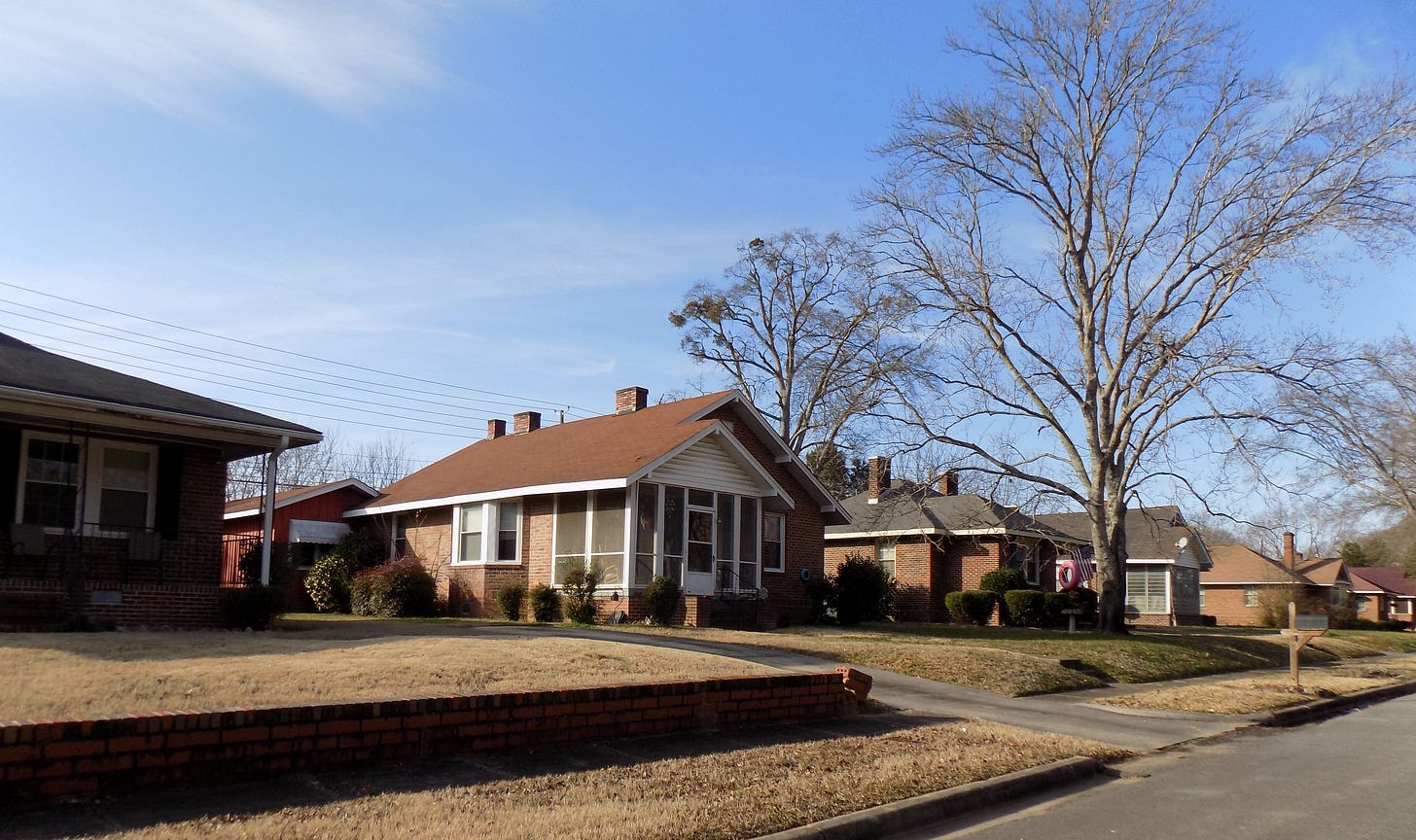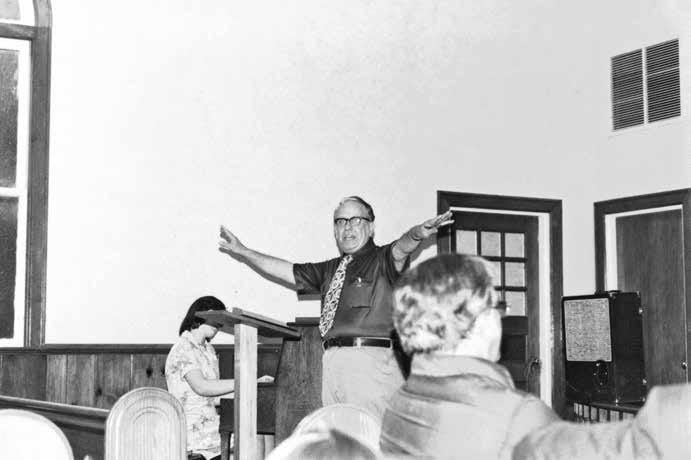Celanese II
Modern Mill Village Amenities
In late April 1928, hundreds of Rome, Georgia, residents gathered at the Floyd County Courthouse. A rayon mill had shortlisted Rome for a new facility. Within two days, the Chamber of Commerce raised $115,000 in subscriptions. City and county officials pledged to move the water source upriver and to build a road.
On May 8, 1928, almost 3,000 people attended a parade to the construction site two miles north of the city. Italian and American officials laid a cornerstone containing rayon, flags, and a commemorative newspaper. Nearly all white Romans gathered that afternoon. Black residents, later denied production jobs, were not mentioned in newspaper accounts.
The American Chatillon Corporation, owned by Italian firm La Soie de Chatillon, initially refused to build worker housing. Local developers rushed to build subdivisions like “Riverside” and “DeSoto Heights” near the plant. Within weeks, contractors were building “a house a day.”
It wasn’t enough. By late August 1928, ten or twelve families arriving for construction work couldn’t find housing. Some lived in a “tent city” next to the mill. The Chamber of Commerce requested that locals offer rentals. Within twenty-four hours, fifty homes responded. Most workers needed more than one room.
In November 1928, Chatillon contracted the A.K. Adams Company and Lockwood-Greene to build what would become the Southeast’s most modern mill village.
Developers built 338 brick homes, abandoning plans for wooden houses. Workers chose from five floor plans with three to six rooms, plus efficiency duplexes. Every home had indoor plumbing, electricity, porches, and garden space—amenities some rural workers had never experienced. Professionals from Italy, France, Germany, and the northern states lived in twenty-five homes managed by the section. The separation between managers and workers was similar to the racial divide in the village, where only white families were allowed to live in those homes.
Earle Sumner Draper’s Riverside design featured curved streets, differing from other mill villages. Sidewalks connected front doors, while alleys linked neighbors' back doors back door to back door. The layout suggested suburban middle-class aspirations rather than industrial necessity.
The houses featured varied roof shapes and details like Tudor porch trim and bay windows. Three-room houses had asymmetrical facades with small, recessed porches and pyramidal roofs. Four-room houses came in two styles: one with a small porch and a side-gabled roof; another with a hipped pyramid roof. Five-room houses featured front-gabled rooflines with Tudor Revival details and bay windows. Six-room models had irregular hipped roofs with projecting gables and multiple porches. Even efficiency duplexes maintained architectural quality beyond typical mill housing.
Dr. Ugo Mancini, the Italian resident manager and vice president, occupied a structure that had been transformed from its log cabin origins. No one seemed to notice the irony of an Italian business manager living in a home that was once connected to Native people while managing a workforce that was segregated.
Village amenities rivaled larger towns. The company built a school that opened in October 1929 with 235 students. A baseball diamond with grandstands hosted a championship semi-pro company team for white players. The “Colored Tornadoes,” formed in 1931, was called the best-equipped Black club in Northwest Georgia. Tennis courts and a swimming pool completed the facilities, both reserved for whites. The company store and Rayon Pharmacy became social centers where workers shopped and gathered, their credit monitored by company bookkeepers.
Monte Wood arrived in Rome in the fall of 1937, fleeing a troubled past. The 21-year-old from rural South Georgia had lost his mother and been abandoned by his father. He applied at the rayon mill after being suspended from Berry College for making illegal wine.
Personnel director Wallace Eaves said there were no openings, but to leave contact information. Having neither a telephone nor an address, Wood took a job at Howell’s Grocery for $12 per week. Each time Eaves shopped there, Wood reminded him: “You can phone me at Howell’s Grocery, number 2.” Finally, the call came. The job was in Viscose Spinning—” the hardest job in the worst working conditions in the entire plant,” according to Wood.
Viscose (rayon) is a semi-synthetic product made from wood cellulose. The fabric resembles silk and is breathable and moisture-wicking. Ironically, workers used toxic chemicals in enclosed spaces with poor ventilation. Workers emerged from shifts drenched in sweat, clothes reeking of sulfur.
Wood jumped into viscose production and became part of the Celanese community. By 1941, Monte and his wife Marie had moved to a five-room house at 32 Locust Street. In 1954, they bought a six-room house at 28 Ash Street for $4,620.
Around this time, Ruby Mae Fletcher navigated different possibilities within the mill’s segregated structure. A Black woman from East Rome, Fletcher worked as a domestic servant in white village homes, earning approximately two dollars per day—about one-tenth of what white production workers made. Randy Conway, whose family employed Fletcher, recalled her as a “surrogate parent” who cared for white children. “Her home was a shack on a steep hill in east Rome,” Conway remembered, “and even at that early age I was struck by the poverty she lived in.” Fletcher’s labor enabled the middle-class domesticity that white families enjoyed, yet she remained invisible in official accounts. She appears in no company photographs, earned no mention in the Tubize Spinnerette, and left no interview in the archives. Only in the memories of white children she cared for does her presence emerge.
The contrast between Wood’s trajectory and Fletcher’s stasis reveals the village’s fundamental inequalities. Wood could leverage persistence and performance into advancement—from viscose spinning to better positions, from renting to owning, from four rooms to six. Fletcher’s race limited her to service work regardless of capabilities or ambitions. Because of WWII, Black people were hired in factories but were later fired when white veterans came back. Not until 1962 did the company hire Black workers for production jobs, and even then, resistance ran deep.
Next week in “Celanese Part III”:
Experience a day in the Village. To conclude this three-part series, which focuses on the mill’s final day.
If you have any stories about working at Celanese/Tubize, please contact me at spoutsprings30161@gmail.com. If you have any stories about Rome and /or Floyd County, I would like to tell them for you.
Russell, Lisa M. Lost Mill Towns of North Georgia. Charleston: Arcadia Publishing, 2020.
Simpson, Lydia B. “All Roads Lead: From Ancient Silk Road to Multinational Synthetic Fibers In a southern Appalachian town.” PhD diss., Middle Tennessee State University, 2017.




